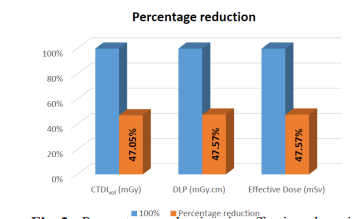Abstract
Introduction: The objective of our study was to
evaluate diagnostic acceptability of image quality in
High Resolution Computed Tomography (HRCT)
of chest with 50% reduction in effective mAs.
Materials and Methods: This prospective crosssectional study was done in 104 patients with BMI
less than 30 kg/m2
who underwent HRCT chest
examination in Tribhuvan University Teaching
Hospital (TUTH) for the period of 4 months
from August to November 2017. CT scans were
performed on the Siemens Somatom Definition
AS+ 128 slice CT scanner. 52 patients were scanned
with routine HRCT protocol of the department
while another 52 patients were scanned reducing
the effective mAs selected by CARE Dose4D by
50% (low dose HRCT chest protocol), keeping
other parameters unchanged. The first patient was
scanned with the routine protocol while the next
patient was scanned reducing the effective mAs
by 50% and so on alternately. These images were
evaluated by faculty radiologist and the overall
image quality was assessed and scored on 4 point scale ranging from 1 to 4, (1= Excellent, 2= Very
Good, 3= Fair, 4= Poor).
Results: There was no statistically significant
difference between the images obtained by routine
protocol and with low dose protocol across all BMI
categories (p<0.05). Reduction of effective dose
was found to be 50.71%, 47.52% and 45.94% in
overweight (25-30 kg/m2
), underweight (below
18.5 kg/m2
) and normal (18.5-24.9 Kg/m2
) BMI
category respectively, with overall average dose
reduction of 48%.
Conclusion: Image quality of low dose protocol is
acceptable for patients with BMI less than 30kg/m2.
Thus, reduction in radiation dose by approximately
50% is possible by using a low dose HRCT chest
protocol.
References
Hamberg LM, Blake MA, Shepard
J-A, et al. Strategies for CT radiationdose optimization. Radiology
[Internet]. 2004 Mar.;230(3):619–28.
2. Smith-Bindman R, Lipson J, Marcus
R, Kim K-P, Mahesh M, Gould R, et
al. Radiation dose associated with
common computed tomography
examinations and the associated
lifetime attributable risk of cancer.
Arch Intern Med . 2009 Dec
14;169(22):2078–86.
3. Brenner DJ, Elliston CD, Hall EJ,
Berdon WE. Estimated Risks of
Radiation-Induced Fatal Cancer from
Pediatric CT. Am J Roentgeno. 2001
Feb;176(2):289–96.
4. Yu L, Liu X, Leng S, Kofler JM,
Ramirez-Giraldo JC, Qu M, et al.
Radiation dose reduction in computed
tomography: techniques and future
perspective. Imaging Med. 2009
Oct;1(1):65–84.
5. Aweda MA, Arogundade RA.
Patient dose reduction methods
in computerized tomography
procedures : A review. Int J Phys Sci.
2007;2(1):1–9.
6. Singh S, Kalra MK, Ali Khawaja RD,
Padole A, Pourjabbar S, Lira D, et al.
Radiation Dose Optimization and
Thoracic Computed Tomography.
Radiol Clin North Am. 2014
Jan;52(1):1–15.
7. Kubo T, Ohno Y, Nishino M, Lin P-J,
Gautam S, Kauczor H-U, et al. Low
dose chest CT protocol (50mAs) as
a routine protocol for comprehensive
assessment of intrathoracic
abnormality. Eur J Radiol Open.
2016;3:86–94.
8. Livingstone R, Pradip J, Dinakran P,
Srikanth B. Radiation doses during
chest examinations using dose
modulation techniques in multislice
CT scanner. Indian J Radiol Imaging.
2010 May;20(2):154.
9. Ley-Zaporozhan J, Ley S,
Krummenauer F, Ohno Y, Hatabu
H, Kauczor H-U. Low dose multidetector CT of the chest (iLEAD
Study): Visual ranking of different
simulated mAs levels. Eur J Radiol
[Internet]. 2010 Feb;73(2):428–33.
Available from : http://www.ncbi.
nlm.nih.gov/pubmed/ 19054639
10. European guidelines on quality
criteria for Computed Tomography
[Internet].Available from: http://
www.drs.dk/guidelines/ct/quality/
htmlindex. html
11. Prasad SR, Wittram C, Shepard
J-A, McLoud T, Rhea J. StandardDose and 50%— Reduced-Dose
Chest CT: Comparing the Effect on
Image Quality. Am J Roentgenol.
2002 Aug;179(2):461–5. Available
from: http:/www.ajronline.org /
doi/10.2214/ajr.179.2.1790461
12. Corneloup O, Delval O, Laurent F,
Morin M, Vandermarcq P. [Low-dose
chest CT with millimetric thin slices:
myth or reality?]. J Radiol. 2003
Mar;84(3):305–10.
13. Takahashi M, Maguire WM,
Ashtari M, Khan A, Papp Z,
Alberico R, et al. Low-dose spiral
computed tomography of the thorax:
comparison with the standard-dose
technique. Invest Radiol. 1998
Feb;33(2):68–73.
14. Zhu X, Yu J, Huang Z. Low-Dose
Chest CT: Optimizing Radiation
Protection for Patients. Am J
Roentgenol. 2004 Sep;183(3):809–
16.
15. Naidich DP, Marshall CH, Gribbin
C, Arams RS, McCauley DI. Lowdose CT of the lungs: preliminary
observations. Radiology. 1990
Jun;175(3):729–31.
16. Zwirewich C V, Mayo JR, Müller
NL. Low-dose high-resolution CT of
lung parenchyma. Radiology. 1991
Aug;180(2):413–17
17. Ambrosino MM, Genieser NB,
Roche KJ, Kaul A, Lawrence RM.
Feasibility of high-resolution, lowdose chest CT in evaluating the
pediatric chest. Pediatr Radiol . 1994
Mar;24(1):6–10.
18. Lee KS, Primack SL, Staples CA,
Mayo JR, Aldrich JE, Müller NL.
Chronic infiltrative lung disease:
comparison of diagnostic accuracies
of radiography and low- and
conventional-dose thin-section CT.
Radiology. 1994 Jun 1;191(3):669–
73.
19. Mayo JR, Hartman TE, Lee KS,
Primack SL, Vedal S, Müller NL. CT
of the chest: minimal tube current
required for good image quality
with the least radiation dose. Am J
Roentgenol. 1995 Mar;164(3):603–8

